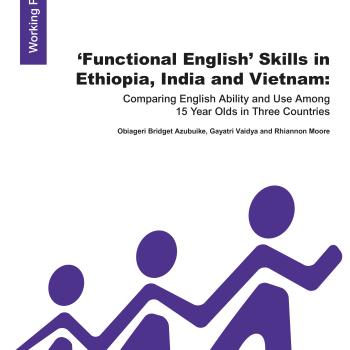
Increased globalisation, interconnectivity and overall exposure have promoted a considerable increase in developing countries in usage and aspiration to learn the English language. Among policymakers and individuals, English is considered important for economic advancement, employment and social mobility. In line with this, Young Lives included a ‘functional English’ assessment as part of its 2016-17 school survey with 15 year olds in Ethiopia, India and Vietnam, providing a unique opportunity to explore English language learning outcomes and some of the factors which affect these.
This working paper explores how functional English can be conceptualised, recognising the multiple ways in which young people in these diverse contexts may want to use English now and in the future. It also draws on analysis of data from the Young Lives school survey to consider the level of functional English competency which children in the three countries currently have, and how this relates to the types of English required by labour markets or higher levels of education. The paper examines the disparities in English levels within the three countries, including some of the background characteristics associated with higher levels of English, and discusses the implications of such gaps on the equality of education and employment opportunities in the future.

Increased globalisation, interconnectivity and overall exposure have promoted a considerable increase in developing countries in usage and aspiration to learn the English language. Among policymakers and individuals, English is considered important for economic advancement, employment and social mobility. In line with this, Young Lives included a ‘functional English’ assessment as part of its 2016-17 school survey with 15 year olds in Ethiopia, India and Vietnam, providing a unique opportunity to explore English language learning outcomes and some of the factors which affect these.
This working paper explores how functional English can be conceptualised, recognising the multiple ways in which young people in these diverse contexts may want to use English now and in the future. It also draws on analysis of data from the Young Lives school survey to consider the level of functional English competency which children in the three countries currently have, and how this relates to the types of English required by labour markets or higher levels of education. The paper examines the disparities in English levels within the three countries, including some of the background characteristics associated with higher levels of English, and discusses the implications of such gaps on the equality of education and employment opportunities in the future.

